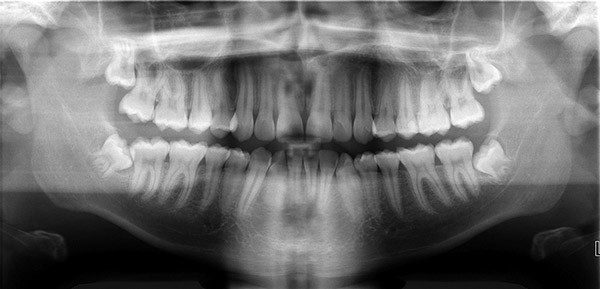Medical/Health
The diver, a 40-year-old male with more than 1500 lifetime dives, had no known medical conditions and reported a healthy lifestyle. In the months before this incident, he had had multiple root canals and other major dental work done.
He made several decompression dives on a rebreather using a scooter without any problems in the week preceding the incident.
THE INCIDENT
On his last dive of a week-long series, the diver felt a momentary dull pressure and pain in his lower teeth during his descent. He dismissed it from his mind, because the pain seemed to vanish as he continued with the dive to a maximum depth of 47m.
When he started to ascend after spending 30 minutes at 41m, he experienced sharp and severe pain in the same teeth. After ascending an additional 2m or so, he became aware that several dental fillings had come loose.
As he continued his ascent, two fillings fell apart and came out of his teeth. He halted the ascent for a few minutes to compose himself and assess how to reach the surface safely before proceeding.
To avoid further complications and prevent the dental-filling debris from damaging the bail-out valve of his rebreather, he switched to his backup open-circuit unit and spat out the filling fragments. He then returned to the closed-circuit loop to conserve breathing gas.
His dive-buddy was attentive and assisted him with his scooter and reel throughout the ascent. The diver stayed at 29m for 10 minutes to deal with the excruciating pain he felt throughout his lower teeth before proceeding with a safe ascent to the surface.
THE DIAGNOSIS
Several days after the incident the diver went to his dentist, who suggested that biting too hard on the regulator mouthpiece had generated pain similar to that caused by “bruxing”, the grinding or clenching of the teeth.
Diagnostic X-rays showed that the amalgam (metal) fillings in five of the diver’s teeth were either damaged or missing entirely.
Defective fillings may have allowed air to enter between the filling and the tooth and become trapped. During ascent the trapped air expanded and created pressure against the internal structures of the tooth, which triggered the tooth pain and caused two of the fillings to fall out.
The dentist replaced the damaged fillings, but the diver continued to experience tooth pain when diving.
He sought a second opinion from another dentist, who identified through further X-rays that there were problems with the fillings of four of his teeth, and recommended replacement. The diver had the fillings replaced and returned to diving without experiencing tooth pain.
This was a case of barodontalgia, tooth pain caused by a change in ambient pressure, also known as dental barotrauma.
DISCUSSION
As a diver descends into the water, the ambient pressure increases by one atmosphere for every 10m depth. This pressure change affects body cavities such as the ears and sinuses by creating unequal pressures between the body cavity and the ambient environment. This is relieved by equalising pressure.
When a tooth is damaged, restored defectively or has a loose crown, an opening may allow air to enter into the space and become trapped during a dive, with no means of being equalised.
The diver may experience tooth pain during descent, when pockets of air that exist under defective fillings are compressed, or during ascent as the trapped air expands and may crack teeth or loosen or expel fillings.
In this case, the diver had tooth pain on ascent due to defective fillings, which subsequent dental diagnostics confirmed. The unusual aspect was that a total of five teeth appeared to have been affected on the same dive, two of which were confirmed to have lost fillings during that period.
Barodontalgia generally originates with poor oral health, neglected dental maintenance and/or ineffective dental treatments. Of the 347 total cases of barotrauma reported in the 2008 edition of the DAN Annual Diving Report, two cases were categorised as barodontalgia.
Although considered a rare occurrence, barodontalgia should not be dismissed. It can lead to potential safety risks such as rapid ascents and impaired judgment during a dive because of the severe pain.
This case, in which as many as five teeth were affected by barodontalgia during the same dive, is extreme. However, it serves as a reminder that being fit to dive is holistic and includes dental health.
PRECAUTIONS
It isn’t necessary to seek a dentist specifically trained in dive medicine for dental check-ups; rather, it’s important to visit routinely a dentist that provides good-quality care, so that you can be confident your dental health is maintained.
The FDI World Dental Federation advises that divers should have regular dental checkups, refrain from diving (or flying in non-pressurised cabins) within 24 hours of any dental treatment that requires anesthetic, and wait seven days after an oral surgical procedure before returning to diving.
Fillings are prone to deterioration over time. Semi-annual dental exams allow the dentist to inspect existing fillings for damage and to detect and treat tooth decay in a timely manner.
By maintaining good oral health, divers can avoid barodontalgia and smile easily after diving.
MEDICAL VIEW
DAN Europe is a not-for-profit worldwide organisation that provides emergency medical advice and assistance for underwater diving injuries. It also promotes diving safety through research, education, products and services
| ASK DAN’S EXPERTS
I have been diagnosed with a 2nd Grade Patent Foramen Ovale (PFO). I know I can undergo surgery and have it closed with an umbrella device. Would this be a resolution? Can I dive regularly after it? In accordance with Swiss Underwater & Hyperbaric Medical Society guidelines, a diver with a 2nd and 3rd Grade PFO can dive according to “low-bubble diving recommendations”: To cut risk of bubble transfer into the arterial bloodstream: |

